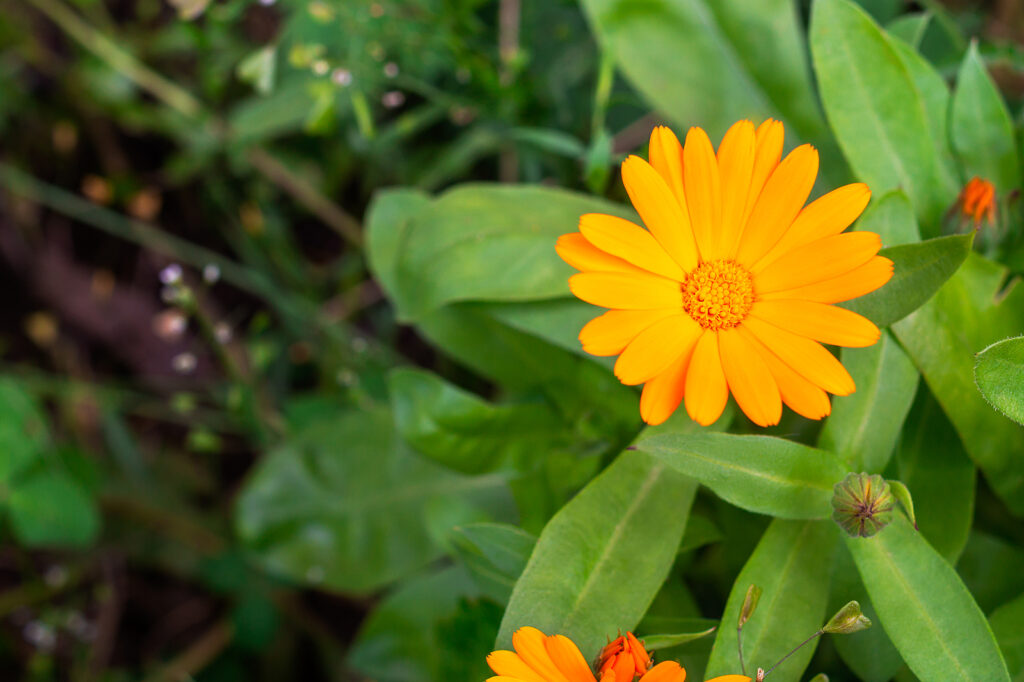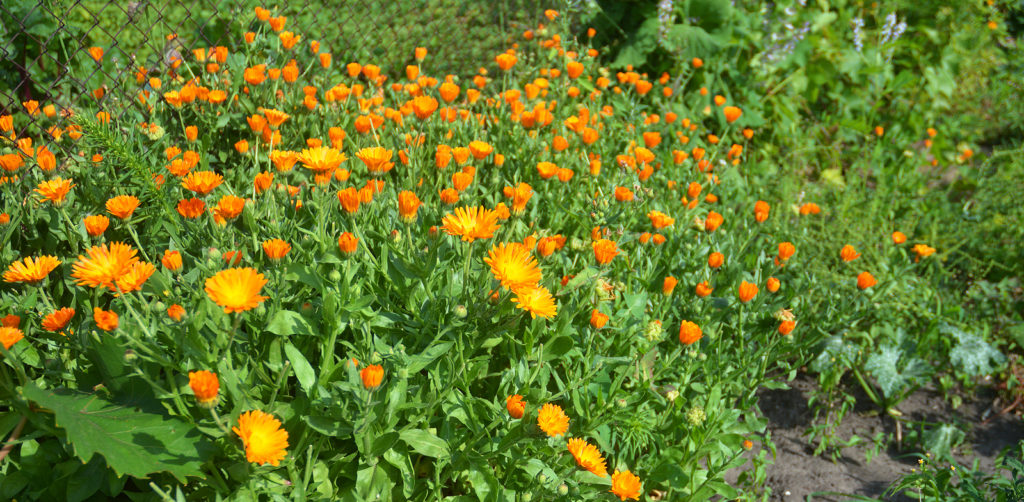Calendulas are a colorful addition to the herb garden. The calendula’s daisy-like flowers are bright yellow and orange and are as easily grown in containers as they are in planting beds. The calendula is also known as pot marigold because cooks toss calendula blossoms into pots to thicken and color soups and stews. Calendula flowers also add a peppery flavor to salads, sandwiches, soups, and stews.
Here is your complete guide to growing calendula.
Where to plant calendula
- Best location: Calendula prefers full sun in the northern regions and partial shade in the southern regions. Calendula is intolerant of intense heat and crowding. In hot regions calendula may die in midsummer; plant calendula in dappled shade in hot summer regions.
- Soil preparation: Plant in compost-rich, well-drained, and moisture-retentive soil. Calendulas grow best when the soil has a pH of 6.6.

When to plant calendula
- Seed starting indoors: Calendulas can also be started indoors and transplanted out to the garden when the soil is workable; avoid transplanting seedlings into the garden when temperatures are hot. In Zone 5 or colder, start seeds indoors about 8 weeks before the last spring frost date. Seeds take 7 to 14 days to germinate. In southern regions, sow seed outdoors in fall.
- Outdoor planting time: In Zone 5 or colder, transplant calendula seedlings to the garden a week or two before the last spring frost. In Zones 5 to 6, plant seeds outside after the soil warms to 60° In Zones 7 to 10, sow seeds outdoors in fall, where they are to grow.
How to plant calendula
- Planting depth: Sow seeds ¼ to ½ inch deep.
- Spacing: Space calendula plants 8 to 10 inches apart.
- How much to plant: Grow 6 calendula plants for culinary use; grow 12 plants for preserving.
Calendula companion plants
- Companion planting: It is said that calendula protects vegetables against asparagus beetles and tomato hornworms. Calendulas attract aphids, whiteflies, and thrips; use calendula as a trap plant to keep pests away from nearby herbs and vegetables.
Watering and feeding calendula
- Watering: Grow calendulas in evenly moist soil.
- Feeding: Feed calendulas with an all-purpose organic fertilizer such as 5-5-5 or 10-10-10.
Calendula care and maintenance
- Care: Deadhead calendula regularly to keep plants blooming throughout the summer. Cut plants back to about 3 inches after the first bloom and they will regrow to bloom again. Provide good air circulation and drainage to prevent powdery mildew and other fungal diseases from attacking calendula.
- Mulching: In hot regions mulch around mature plants to retain soil moisture and keep roots cool.
Container growing calendula
- Container growing: Start calendula seeds indoors then transplant them out to containers when they are 3 or 4 inches tall. Choose a pot at least 6 inches wide and deep; larger for multiple plants. Plant calendula in mid to late summer for indoor fall color.
- Winter growing: In mild-winter regions, calendulas will bloom outdoors all winter.
Calendula pests and diseases
- Pests: Calendulas can be attacked by slugs, snails, aphids, whiteflies, leafhoppers, and thrips. Handpick snails or slugs or drown them in a shallow can of beer set at soil level. Control aphids, leafhoppers, whiteflies, and thrips with insecticidal soap or knock them off plants with a strong blast of water.
- Diseases: Calendulas are susceptible to fungal diseases including leaf spot, downy mildew, and powdery mildew. Space plants so that there is plenty of air circulation and do not use overhead irrigation. Control stem rot by allowing the soil to go dry just before watering again.
How to harvest calendula
- When to harvest: Harvest calendula flowers just after they open fully throughout spring and summer, gathering them in the morning when the dew is dry. Do not harvest flowers going to seed.
- How to harvest: Harvest flowers with a snip or garden scissors.
Calendula in the kitchen
- Flowers: Calendula flowers have a mild peppery flavor; they have no fragrance. Remove the petals from the center of the flower; sprinkle the petals over salads, soups, stews, sandwiches, cheeses, eggs, butter, cakes, cookies, and puddings. Dried petals can be used as a food coloring; add a half cup of petals to soup or broth to give the dish a golden glow. Dried petals can be used as a substitute for saffron.
Preserving and storing calendula
- Drying: Separate petals and lay them on parchment paper in a dehydrator or between sheets of brown paper in the shade. Keep petals from touching each other or they may discolor as they dry.
- Storing: Store dried petals in an airtight, moisture-proof container in a dark dry location.

Calendula propagation
- Seed: Grow calendula from seeds. Calendula easily self-sows; allow a few seedheads to remain in the garden to sow for next spring.
Get to know calendula
- Botanical name and family: Calendula officinalis; calendula is a member of the Asteraceae–daisy family.
- Type of plant: Calendula is a herbaceous annual.
- Growing season: Spring, summer, and fall
- Growing zones: Calendula grows in zones 3 to 10.
- Hardiness: Calendula is resistant to cold weather down to 25°F; calendula is a cool-weather plant; it does not do well in the heat.
- Plant form and size: Calendula plants are mounding plants 12 to 15 inches tall with narrow long leaves that are aromatic and slightly sticky. There are hybrid dwarf varieties half the size.
- Flowers: Calendulas have bright yellow or orange daisy-like double or semi-double flowers 2 to 4 inches across. There is one flower on each stem.
- Bloom time: Calendula blooms from midsummer to after frost. Flowers close at night and reopen in the morning.
- Leaves: Calendula has pointed oblong or oval leaves to 3 inches long on angular stems; leaves have smooth edges and a prominent middle vein. The upper leaves clasp the stalk.
Also of interest:
- Anise
- Anise Hyssop
- Arugula
- Basil
- Bay
- Bee Balm
- Borage
- Calendula
- Caraway
- Catnip
- Chamomile
- Chervil
- Chives
- Cilantro-Coriander
- Clary
- Costmary
- Cress
- Dill
- Fennel, Sweet
- Horseradish
- Hyssop
- Lavender
- Lemon Balm
- Lemon Verbena
- Lovage
- Marjoram
- Mint
- Nasturtium
- Oregano
- Parsley
- Perilla
- Rosemary
- Sage
- Salad Burnet
- Savory
- Scented Geranium
- Shiso
- Sorrel
- Stevia
- Sweet Cicely
- Tarragon
- Thyme
Related articles:
Best Herbs for Container Growing
Planning the Home Fruit Garden
Garden Planning Books at Amazon:
- Vegetable Garden Almanac & Planner
- Kitchen Garden Grower’s Guide Vegetable Encyclopedia
- Vegetable Garden Grower’s Guide
- Tomato Grower’s Answer Book















